| 1 |
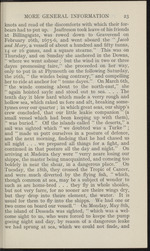 |
“...shipp’s
crew concluded, that our little leakie companion ” (a
small vessel which had been keeping up with them),
“ was buried.” Off the islands called “ the deserts,” a
sail was sighted which “ we doubted was a Turke ” ;
and “ made us putt ourselves in a posture of defence,
and the next morning, findeing that he had chased us
all night . . . we prepared all things for a fight, and
continued in that posture all the day and night.” On
arriving at Madeira they were " verry neare losing our
shippe, the master being unacquainted, and comeing too
boldely in near the shoar, in a dangerous place.” On
Tuesday, the 18th, they crossed the Tropic of Cancer,
and were.much diverted by the flying fish, "which,
though common at sea, may be a subject of wonder to
such as are home-bred . . . they fly in whole shoales,
but not very farre, for no sooner are theire wings dry,
but they drop into theire element, the water. It is
usual for them to fly into the shipps. We had one or
two come on board our vessell.” On...”
|
|
| 2 |
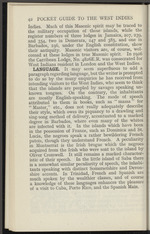 |
“...No. 4826E.R. was consecrated for
West Indians resident in London and the West Indies.
LANGUAGE. It may seem superfluous to add a
paragraph regarding language, but the writer is prompted
to do so by the many enquiries he has received from
intending visitors to the West Indies, who seem to think
that the islands are peopled by savages speaking un-
known tongues. On the contrary, the inhabitants
are mostly English-speaking. The mode of speech
attributed to them in books, such as “ massa ” for
" Master,” etc., does not really adequately describe
their style, which owes its piquancy to a drawling and
sing-song method of delivery, accentuated to a marked
degree in Barbados, where even many of the whites
are infected with it. In the islands which have been
in the possession of France, such as Dominica and St.
Lucia, the negroes speak a rather bewildering French
patois, though they understand French. A peculiarity
in Montserrat is the Irish brogue which the negroes
acquired from the Irish who were...”
|
|
| 3 |
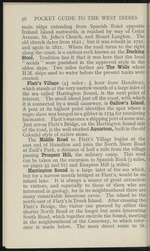 |
“...farther are The Wells where
H.M. ships used to water before the present tanks were
erected.
Platt’s Village (4I miles; \ hour from Hamilton),
which stands at the very narrow mouth of a large inlet of
the sea called Harrington Sound, is the next point of
interest. The small island just off the toast, with which ■
it is connected by a small causeway, is Gallow’s Island. Ml
A post at its highest point identifies the spot where a 11
negro slave was hanged on a gibbet in 1754 f°r murdering I j
his master. Flatt’s was once a shipping port of some size., I
Just across Flatt’s Bridge, on the Harrington Sound side
of the road, is the well-stocked Aquarium, built in the old )
Colonial style of native stone.
The Middle Road to Flatt’s Village begins at the I
east end of Hamilton and joins the North Shore Road K
at Zuill’s Park, a distance of half a mile from the village H
passing Prospect Hill, the military camp. This road!
can be taken on the excursion to Spanish Rock (3 miles, lit
see pages 45 and...”
|
|
| 4 |
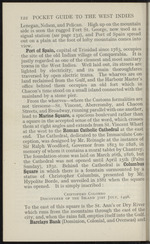 |
“...signal station (see page 132), and Port of Spain spread
out on a plain at the foot of lofty mountains comes into
view. ' .)J
Port oï Spain, capital of Trinidad since 1783, occupies
the site of the old Indian village of Conquerabia. It is
justly regarded as one of the cleanest and.most sanitary
towns in the West Indies. Well laid out, its streets are
lighted by electricity, and its main thoroughfares
traversed by open electric trams. The wharves axe on
land reclaimed from the Gulf, and the Harbour Master s
office behind them occupies an old fort which in
Chacon’s time stood on a small island connected with the
mainland by a stone pier.
From the wharves—where the Customs formalities are
not tiresome—St. Vincent, Abercromby, and Chacon
Streets, and Broadway, running parallel with one another,
lead to Maxine Square, a spacious boulevard rather than
a square in the accepted sense of the word, which crosses
them at right angles and extends from St. Vincent Wharf
at the west to the Roman Catholic Cathedral...”
|
|
| 5 |
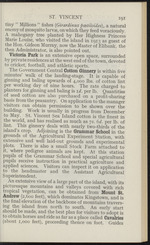 |
“...ST. VINCENT i9i
tiny Millions ” fishes [Girardinus pasciloides), a natural
enemy of piosquito larvae, on which they feed voraciously.
A mahogany tree planted by Her Highness Princess
Marie Louise, who visited the island in 1913 as guest of
the Hon. Gideon Murray, now the Master of Elibank, the
then Administrator, is also pointed out.
Victoria Park is an extensive open space, surrounded
by private residences at the west end of the town, devoted
to cricket, football, and athletic sports.
The Government Central Cotton Ginnery is within five
minutes’ walk of the landing-stage. It is capable of
ginning and baling upwards of 4,000 lbs. of cotton lint
per working day of nine hours. The rate charged to
planters for ,ginning and baling is id. per lb. Quantities
of seed cotton are also purchased on a profit-sharing
basis from the peasantry. On application to the manager
visitors Can obtain permission to be shown over the
building. Work is usually in progress from December
to May. St. Vincent Sea...”
|
|
| 6 |
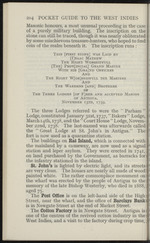 |
“...204 POCKET GUIDE TO THE WEST INDIES
Masonic honours, a most unusual proceeding in the case
of a purely military building. The inscription on the
stone can still be traced, though it was nearly obliterated
by some mischievous treasure-hunters, who hoped to find
coin of the realm beneath it. The inscription runs :
This [first stone] was Laid by
[I]saac Mathew . ,
The Right Worshipfull
[The] Provincial] Grand Master
With his [GraJnd Officers
And
The Right W[or]shipfull the Masters
And
The Wardens [and] Brothers
OF
The Three Lodges [of F]ree and accepted Masons
of Antigua.
November 15m, 1739.
The three Lodges referred to were the “ Parham ”
Lodge, constituted January 31st, 1737, “ Bakers ” Lodge,
March 14th, 1738, and the “ Court House ” Lodge, Novem-
ber 22nd, 1738. The last-named was afterwards called
the " Great Lodge at St. John’s in Antigua.” The
fort is now used as a quarantine station.
The buildings on Bat Island, which is connected with
the mainland by a causeway, are now used as a...”
|
|
| 7 |
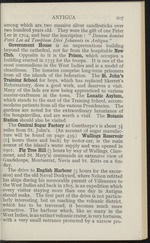 |
“...building
beyond the cathedral, not far from the hospitable New
Club. Opposite to it is the Prison, which occupies a
building erected in 1735 for the troops. It is one of the
most commodious in the West Indies and is a model of
cleanliness. The inmates comprise long-term prisoners
from all the islands of the federation. The St. John’s
Training School for boys, which has replaced Skerret’s
Reformatory, does a good wtork, and deserves a visit.
Many of the lads are now being apprenticed to various
master-craftsmen in the town. The Lunatic Asylum,
which stands to the east of the Training School, accom-
modates patients from all the various Presidencies. The
gardens are noted for the extraordinary luxuriance of
the bougainvillea, and are worth a visit. The Botanic
Station should also be visited.
The Central Sugar Factory at Gunthorpe’s is about 3 J
miles from St. John’s. (An account of sugar manufac-
; ture will be found on page 439.) Wallings Reservoir
(ij hours there and back) by motor-car, is...”
|
|
| 8 |
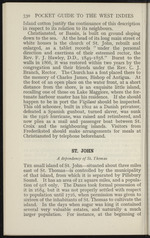 |
“...direction and exertions of their esteemed rector, the
Rev. F. J. Hawley, D.D., 1849-1858.” Burnt to the
walls in 1866, it was restored within two years by the
congregation and their friends under the Rev. C. J.
Branch, Rector. The Church has a font placed there to
the memory of Charles James, Bishop of Antigua. At
the foot of an open place on the water front, at a short
distance from the shore, is an exquisite little island,
recalling one of those on Lake Maggiore, where the for-
tunate harbour master has his residence. If she should
happen to be in port the Vigilant should be inspected.
This old schooner, built in 1802 as a Danish privateer,
defeated a Spanish gunboat, turned slaver, was sunk
in the 1916 hurricane, was raised and retimbered, and
now plies as a mail and passenger boat between St.
Croix and the neighbouring islands. Visitors from
Frederiksted should make arrangements for meals at
Christiansted by telephone beforehand.
ST. JOHN
A dependency of St. Thomas
The small island of...”
|
|
| 9 |
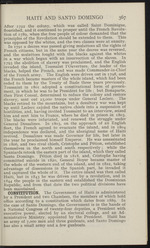 |
“...island, and in 1804
independence was declared, and the aboriginal name of Haiti
revived! Dessalines was made Governor for life, but later in
the year he proclaimed himself Emperor. He was assassinated
in 1806, arid two rival chiefs, Cristophe and Pétion, established
themselves in the north and south respectively; while the
Spaniards retook the eastern part of the island, which they called
Santo Domingo. Pétion died in 1818, and, Cristophe having
committed suicide in 1820, General Boyer became master of
the whole of the western end of the island, and in 1822, taking
advantage of dissensions in the Spanish part, he invaded it
and captured the whole of it. The entire island was then called
Haiti, but in 1843 he was driven out by a revolution, and in
1844 the people in the eastern end established the Dominican
Republic, and from that date the two political divisions have
been maintained.
CONSTITUTION. The Government of Haiti is administered
by a President and two Chambers, the members of which...”
|
|
| 10 |
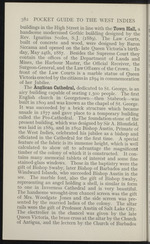 |
“...382 POCKET GUIDE TO THE WEST INDIES
buildings in the High Street in line with the Town Wall, a ’
handsome modernised Gothic building designed by the j
Rev. Ignatius Scoles, S.J. (1889). The Law Courts, 1
built of concrete and wood, were designed by Baron
Siccama and opened on the late Queen Victoria’s birth-
day, May 24th, 1887. Besides the Supreme Court they '
contain the offices of the Department of Lands and
Mines, the Harbour Master, the Official Receiver, the J
Surgeon-General, and the Law Officers of the Crown. In
front of the Law Courts is a marble statue of Queen
Victoria erected by the citizens in 1894 in commemoration
of her Jubilee.
The Anglican Cathedral, dedicated to St. Gèorge, is an
airy building capable of seating 1,500 people. The first
English church in Georgetown-then Stabroek—was
built in 1809 and was known as the chapel of St. George.
It was succeeded by a brick structure which became
unsafe in 1877 and gave place to a temporary building
called the Pro-Cathedral. The...”
|
|
| 11 |
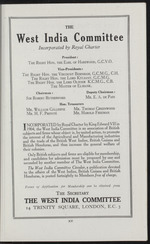 |
“...THE
West India Committee
Incorporated by Royal Charter
President:
The Right Hon. the Earl of Harewood, G.C.V.O.
Vice-Presidents:
The Right Hon. the Viscount Burnham, G.C.M.G., C.H.
The Right Hon. the Lord Kylsant, G.C.M.G.
The Right Hon. the Lord Olivier K.C.M.G., C.B.
The Master of Elibank.
Chairman : Deputy Chairman :
Sir Robert Rutherford Mr. E. A. dePass
Hon. Treasurers
Mr. William Gillespie Mr. Thomas Greenwood
Mr. H. F. Previté Mr. Harold Freeman
T NCORPORATED by Royal Charter by King Edward VII in
A1904, the West India Committee is an association of British
subjects and firms whose object is, by united action, to promote
the interest of the Agricultural and Manufacturing industries
and the trade of the British West Indies, British Guiana and
British Honduras, and thus increase the general welfare of
their colonies.
Only British subjects and firms are eligible for membership,
and candidates for admission must be proposed by one and
seconded by another member of The West India Committee...”
|
|
